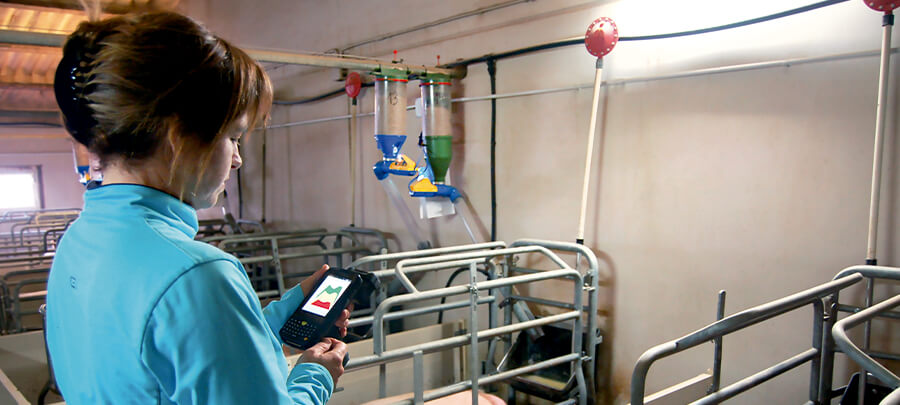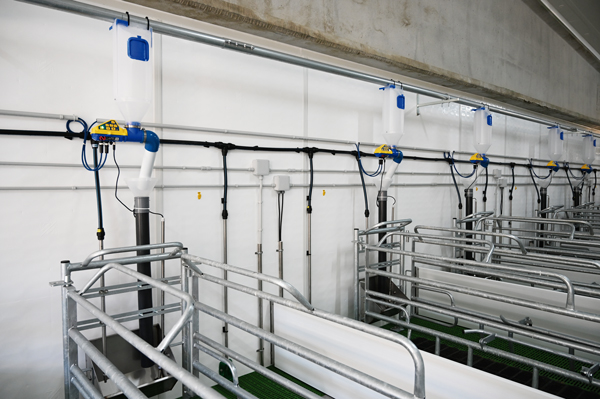Blog
Blog

Precision technology applied to pig farm equipment
23rd February 2023 - News
Óscar Toledano. Sales Manager & BI Rotecna.
The main challenges the pig industry faces are the environmental, economic and social sustainability. And to improve all these aspects applying digital technologies and industry 4.0 concepts is crucial.
To reduce the water and carbon footprint, the emissions of GHG and air pollutants such as ammonia, and avoid the pollution by incorrect use of pig slurry, it is essential to make efficient use of feed and water, empty the pits of the barns often, separate the liquid and solid phases of slurry, acidify or cover the slurry lagunes, characterize the different nutrients of the pig slurry and apply it in the right dose to the right moment according to the needs of the crops.
The main cost of pig production is feed, so to improve the farmers’ profits focusing on reducing feed use is essential. Feed waste must be reduced, feed consumption must be controlled and maximized to improve digestive performance and feed conversion rate, adapt the diet to the animal’s need in every phase, and data collection and processing to detect problems and areas of improvement.
The second main costs are piglets, so reducing piglet mortality has a very positive effect on the business. Sows must be kept in the right corporal condition, increase sow feed intake in farrowing to increase milk yield and fertility and prolificity of next delivery, increase colostrum and milk intake of the piglets, have a sufficient lactation period, improve the transition between milk and feed, improve the transition between different diets, adapt the environment to the needs of the animal in every phase, etc.

Farrowing pens with the Dositronic M electronic feeding system installed. Photo: Rotecna.
We must be aware of the importance of the perception of society about pig farming in many aspects. On one side we need to make our farms attractive to our labor force to attract and retain talent and reduce as much as possible the number of people required to take care of our animals. New generations are native digitals and they like to work with digital devices, we have to automatize all the processes we can, improve the working and safety conditions, provide comfortable facilities, and so on.
On another side consumers are every day more concerned about how their food is produced beyond food safety, giving a lot of importance to animal welfare, so we should go to systems that limit the use of crates and stalls, having the sows in group pens and loose farrowing, providing enrichment material, more space, noncompetitive controlled feeding systems, etc.
There are also changes in the meat consumption trends, some of them because of the concern of how animals are raised and their environmental footprint. We have the means to produce animals with high welfare in a sustainable way, but we have to apply them and make everything as good as possible. We have to improve the image of our farms so people see modern and clean facilities, we also have to be proud of what we do, share it and explain our story to counter the campaigns against our industry.
Let’s see some examples of how to apply industry 4.0 to achieve these:
APPLICATION OF IOT SENSORS TO MONITOR
- Health state of the animals by their behavior and habits, feed and water consumption.
- Environment conditions, temperature, humidity, CO2 and NH3 levels.
- Nutrient composition of pig slurry, application flow, place and time of application.
- Stocks and levels of feed in silos, water in tanks, manure in pits.
- Control of the consumption of energy, water, feed, disinfectants, medicines.
AUTOMATIZATION AND ROBOTS
- Automatic feed delivery systems.
- Automatic mixing systems to make diet transitions.
- Electronic feeding systems to reduce feed waste, control and maximize feed consumption and feed by phases according to animals’ needs.
- Automatic detection of weight and corporal state to feed animals according to their needs.
- Automatic sow heat detection.
- Automatic environment control systems.
- Automatic slurry and manure handling systems.
- Jet washing and disinfection robots.
CLOUD COLLECTED DATA MANAGEMENT AND AI
- Cloud data processing.
- Data access by selected people from any device in any place.
- Detect problems and areas of improvement.
- Improving the overall equipment effectiveness.
- Set the automatics processes according to performance.
- Predict technical problems.
BLOCKCHAIN
- Data privacy and security.
- Improve the logistics.
- Improve traceability of every process.
SOCIAL MEDIA
- To explain how good we do the things.
- To show how proud we are of what we do.
- To give our version and explain our story.
We have the knowledge and technologies to face all the challenges we have in front of us, if we apply them, we will have a bright and amazing future for us and our farms.
The cost of the farms represents less than 10% of the production cost, so it is completely viable to face these challenges. However, at Rotecna we are aware of the challenge that implementing technology in a pig farm successfully represents. This process must be done gradually, starting with the technologies that have a big impact on the farmers’ profits and wellbeing, and making sure the user interface is simple enough so that everybody can use them.
For this reason we started by the electronic feeding systems for gestation (Dositronic G) to ensure a proper control of feed intake of sows, so they have the right body condition, which determines its performance. The system is very simple to install even in a retrofit building, and there is almost no need to train the sows to use it, as its free access stall it has a very intuitive use.
Then we developed the first real friendly to use electronic feeding system for farrowing (Dositronic M) to reduce feed waste and labor maximizing feed intake, productivity and piglets’ performance.
We followed with a wireless silo level control system (Silotronic) to improve the control of feed stocks and improve the logistics of feed manufacturing and delivery.
We have lately launched a computerized control of feeding systems (Evofeed) that allows to control the amount of each feed delivered to the animals and make a progressive transition between them, in order to deliver the amount of feed that every animal needs by its size and avoid health problems because of the abrupt change of diet. All this without the need of scales or electronic feed valves.
Our product development department is currently working on different projects to keep implementing easy to use technologies to other products to keep improving animals’ welfare and performance and farmers life and profits that you will be enjoy soon.






